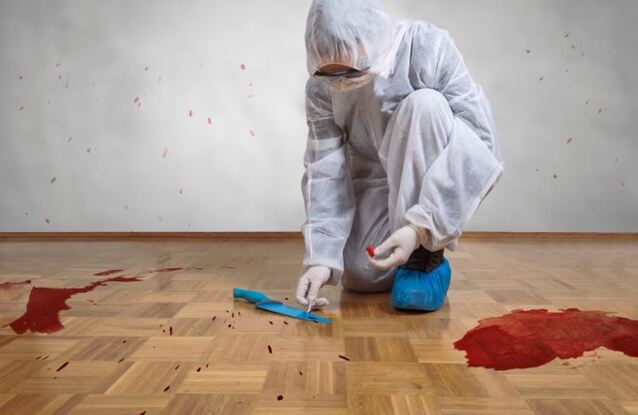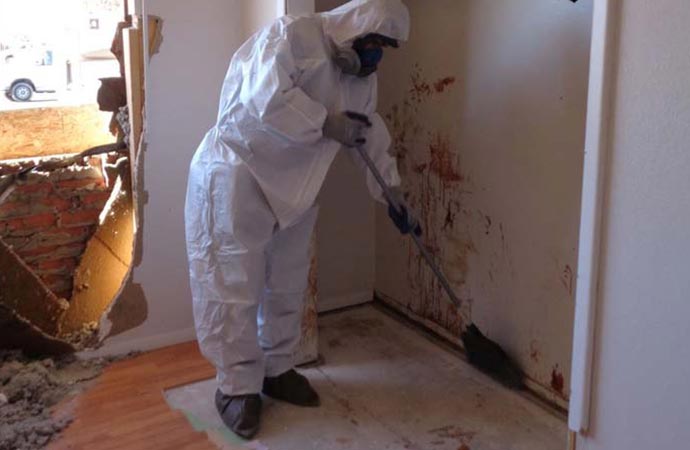Specialist Biohazard Cleansing and Decontamination for Blood, Bodily Fluids, and Hazardous Materials
In the realm of biohazard cleaning and decontamination for blood, bodily liquids, and hazardous products, accuracy and proficiency are paramount. The potential health and wellness dangers connected with exposure to biohazards underscore the critical demand for thorough handling and detailed clean-up. Specialized training furnishes experts with the understanding and abilities required to deal with these unsafe circumstances efficiently. However, it is not just regarding cleaning up; the relevance of utilizing proper purification methods can not be overstated. As we browse the complex landscape of biohazard cleanup, recognizing the nuances of regulations, compliance, and the specialized devices at play becomes essential in making sure a risk-free and thorough purification process.
Wellness Risks of Biohazard Exposure
Exposure to biohazards postures significant health and wellness threats that can cause severe repercussions for communities and individuals alike. Biohazards encompass a vast array of biological substances, including blood, physical fluids, mold, germs, infections, and various other potentially transmittable products. When individuals enter contact with these biohazards, whether with mishaps, improper handling, or environmental exposure, they face the danger of having severe ailments or diseases.
One of the primary health risks associated with biohazard exposure is the transmission of infectious illness. Bloodborne microorganisms such as HIV, hepatitis B and C, and various microorganisms can be existing in biohazardous products, posturing a straight danger to human wellness. Breathing in airborne biohazards like mold spores or entering into contact with contaminated surface areas can additionally bring about respiratory system problems, allergies, and other adverse health results.
In addition, biohazard exposure can have long-term health implications, with some conditions manifesting years after the first get in touch with (Blood Cleanup). Consequently, it is critical to focus on proper biohazard cleaning and purification to reduce these health threats and make sure the security of neighborhoods and individuals

Specialized Training for Biohazard Clean-up
When it comes to managing biohazard cleanup effectively and securely, specialized training plays a fundamental function in ensuring appropriate purification procedures are complied with. Biohazard clean-up calls for specific knowledge and abilities to effectively reduce threats connected with bloodborne pathogens, physical liquids, and dangerous materials. Experts learnt biohazard cleaning undergo extensive direction on just how to safely deal with, eliminate, and dispose of biohazardous products to avoid contamination and exposure.
Specialized training for biohazard clean-up covers a series of crucial topics, including proper personal protective devices (PPE) usage, bloodborne microorganism understanding, purification methods, and contaminated materials disposal methods. People learnt biohazard cleanup are equipped with the necessary know-how to analyze contamination degrees, recognize potential dangers, and execute ideal cleaning procedures in compliance with governing criteria.
Continual training and education and learning are extremely important in the area of biohazard cleaning to remain upgraded on the current decontamination innovations, safety protocols, and regulations. By spending in specialized training, biohazard cleaning specialists can successfully react to emergency cleaning scenarios and secure both public health and wellness and the environment.
Importance of Correct Purification Techniques
Using correct decontamination techniques is crucial in biohazard cleaning to successfully decrease and get rid of harmful materials health threats. Effective purification not only ensures the elimination of visible traces of blood, physical fluids, and various other biohazards however also targets undetectable pathogens that might position serious health and wellness threats otherwise correctly gotten rid Get More Information of. By complying with strict purification procedures, educated experts can significantly minimize the risk of direct exposure to dangerous bacteria, infections, and bacteria that could bring about infections or conditions.
Correct decontamination strategies include using specific devices and disinfectants that are especially developed to counteract discover this biohazards efficiently. Detailed cleaning and disinfection of infected locations are vital to avoid the spread of virus and ensure a risk-free setting for owners. Additionally, the appropriate disposal of biohazardous waste adhering to purification treatments is vital in stopping contamination of various other surfaces or people.

Equipment and Tools for Safe Cleaning
When dealing with blood, physical fluids, or unsafe materials, biohazard cleansing specialists rely on specialized gear to lessen exposure dangers and thoroughly decontaminate the damaged area. In addition, biohazard cleansing packages including anti-bacterials, absorptive products, and biohazard bags are used to securely contain and dispose of polluted things.
Advanced cleaning devices like hospital-grade disinfectants, HEPA-filtered vacuum cleaners, and misting machines are utilized to disinfect surfaces and eliminate biohazards properly. Specialized equipment such as sharps containers and biohazard garbage disposal containers are utilized to safely handle sharp items and biohazardous waste products. By utilizing the best devices and devices, biohazard cleansing professionals can make sure a comprehensive clean-up procedure that prioritizes safety and security and minimizes health and wellness risks for both workers and passengers of the damaged room.
Regulations and Compliance in Biohazard Cleaning
Appropriate adherence to guidelines and conformity criteria is extremely important in biohazard cleansing to ensure the safety of both employees and the environment. Government agencies such as OSHA (Occupational Safety and Health Administration) and the EPA (Epa) have established particular guidelines for biohazard cleanup procedures to minimize wellness dangers and ecological contamination. These guidelines cover a series click this link of elements including the handling, transportation, and disposal of biohazardous materials, as well as the necessary training and safety tools needed for workers included in the cleanup procedure.
Biohazard cleansing business need to stay up-to-date with these regulations to assure that their operations meet the required safety and security criteria. Failure to adhere to these regulations can result in severe effects, consisting of fines, legal activity, and threatening the health of people and the atmosphere. By complying with strict laws and compliance measures, biohazard cleaning companies can effectively mitigate threats and guarantee a secure and extensive cleanup procedure for all parties entailed.
Final Thought
Finally, biohazard cleansing and decontamination call for specialized training, correct techniques, and adherence to laws. Exposure to blood, physical fluids, and harmful materials presents significant health and wellness threats, making it crucial to make use of the best tools and tools for risk-free cleaning. By following stringent methods and guidelines, specialists can effectively alleviate the threats related to biohazard direct exposure and guarantee the safety and security of both themselves and others.
As we navigate the complex landscape of biohazard cleaning, understanding the nuances of guidelines, conformity, and the specialized devices at play comes to be vital in making certain a detailed and secure decontamination process. (Blood Cleanup)
When it comes to managing biohazard cleaning successfully and securely, specialized training plays a fundamental role in guaranteeing appropriate purification treatments are adhered to.Making use of correct purification methods is crucial in biohazard cleanup to efficiently minimize and eliminate hazardous materials health risks. Additionally, biohazard cleansing packages having anti-bacterials, absorbing products, and biohazard bags are made use of to securely dispose and include of contaminated items.
Government firms such as OSHA (Occupational Safety And Security and Health Administration) and the EPA (Environmental Protection Agency) have actually developed certain guidelines for biohazard cleanup treatments to lessen health and wellness dangers and environmental contamination.